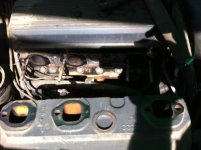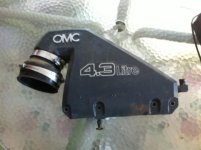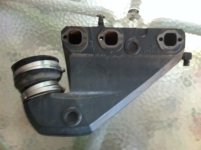My 4.3 L sat for 16 months due to my health issues. It was winterized but not started in that time. (also I live in the San Joaquin Valley, CA, and freezing is rare) When I started it about a month ago it ran fine. I changed the oil, (no water) oil filter, points and plugs. When I started it to check for oil leaks, it purred like a kitten but when I check the oil, the level was higher then before and contained water. The kids and grandkids talked me into delaying the funeral. My investigation reveiled water in the #3 cylinder, but a compression test showed that cylinder as being the highest. (check showed 180 psi as the highest, 155 lowest) I ran the water jacket test, which I found in this forum, and I could not hear any hissing. It seemed like it was holding pressure as well. I do not want to tear into unless there is some hope of bringing it back to life. I have never done major work on an inboard motor so this is why I'm asking if this could be something other then a cracked head, block, or blown gasket. I'm willing to spend some time and money but not if it's a lost cause. I appreciate any help. I've had this boat a long time and it has never let me down before.
Home
Outboard Motor Parts
Chrysler outboard parts Evinrude outboard parts Force outboard parts Honda outboard parts Johnson outboard parts Mariner outboard parts Mercury outboard parts Suzuki outboard parts Tohatsu outboard parts Yamaha outboard partsInboard & Sterndrive Engine Parts
Chrysler Marine inboard parts Crusader Marine parts MerCruiser sterndrive parts OMC sterndrive parts Pleasurecraft Marine parts Volvo Penta marine parts + MoreAll Engine Brands
All Manuals HomeOutboard Repair Manuals
Chrysler outboard manuals Evinrude outboard manuals Force outboard manuals Honda outboard manuals Johnson outboard manuals Mariner outboard manualsMercury outboard manuals Nissan outboard manuals Suzuki outboard manuals Tohatsu outboard manuals Yamaha outboard manuals
Inboard & Sterndrive Engine Manuals
MerCruiser sterndrive manuals OMC sterndrive manuals Volvo Penta marine engine manualsPlease Note
MarineEngine.com does not offer troubleshooting assistance or repair advice by email or by telephone.
You are invited to join our public Boat Repair Forum to seek assistance from other members.
You may also visit the Boat Motor Manuals section of our site to obtain a service manual.





